
If you have yet to travel to Mexico City, then you need to grab your passport and book those flights ASAP! This city is a beacon of culture, history, and cuisine… and it’s waiting for you.
Mexico City is huge. Over 9.2 million people call it home, which means you can guarantee there is always something to do and see.
If you’re an eager traveler like me, it may be hard to stay in one place for a week, but trust me when I tell you that making a trip just to CDMX is well worth it. A full week in Mexico City will give you a real feel for the city, its people, and, of course, the insane food scene.
Add a day trip or two, and you’ll have an amazingly varied trip with not just the capital but some epic nature, ancient ruins, and charming heritage towns.
So let’s jump into your 1 week in Mexico City!
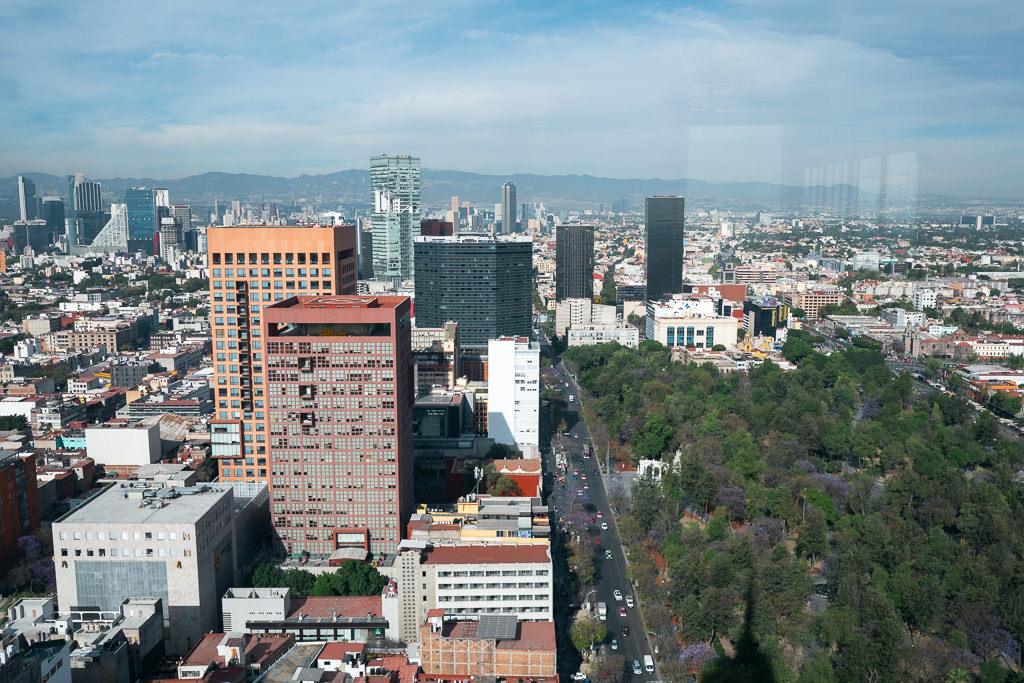 The heart of Mexico City: Alameda Central Park as seen from above
The heart of Mexico City: Alameda Central Park as seen from above
The 3 tours worth doing
Before we break things down into a day-by-day itinerary, a quick word about using tours. They can come in very handy when you’re trying to include several key experiences.
Most things to do in Mexico City—like visiting museums, markets, and monuments—are easy to explore on your own. Just grab a taxi or explore on foot, and enjoy them at your own pace. You’ll find plenty of great recommendations in this guide to help you plan your adventure.
However, from my personal experience, there are 3 activities that you should do with a guide. Firstly, having an expert to show you around will give you a deeper appreciation for a place. Some activities are also much more fun to do as part of a group experience, like cruising Xochimilco’s canals.
These 3 tours are ones I’ve personally done and genuinely recommend—they offer something you just won’t get on your own:
- Exploring Teotihuacán’s Pyramids. Doing it yourself will involve 2 hours of travel one way by metro and bus, but with a tour you’ll get picked up from your hotel. The epic ruins are all the more fascinating when accompanied by a knowledgeable guide who can bring them to life.
- Cruising Xochimilco’s Canals. The drinks and mariachi bands are more fun (and cheaper) in a group. This tour actually covers Xochimilco, Frida Kahlo Museum, Coyoacán, and the university grounds—places far from the center, best done together on a tour
- My Lucha Libre Night Experience. Watching some Mexican wrestling is a fun excursion, but even more so when you have a guide who can explain the meaning of the masks, the plot twists, and tell you who the true baddies are!
Unless you’re on a very tight budget and want to DIY the whole stay, I suggest these particular tours for having the highest added value over self-guided visits.
Day 1: Relaxed exploration in Roma and Condesa
Since we have a full week, let’s ease into things slowly. While many itineraries will have you rushing right to the main square, I suggest taking this first day to acclimate and explore Roma and Condesa, two of the prettiest neighborhoods in Mexico City.
You can wander around, shop in local tianguis (outdoor markets), or window shop and enjoy people-watching at one of the many cafes that line the streets.
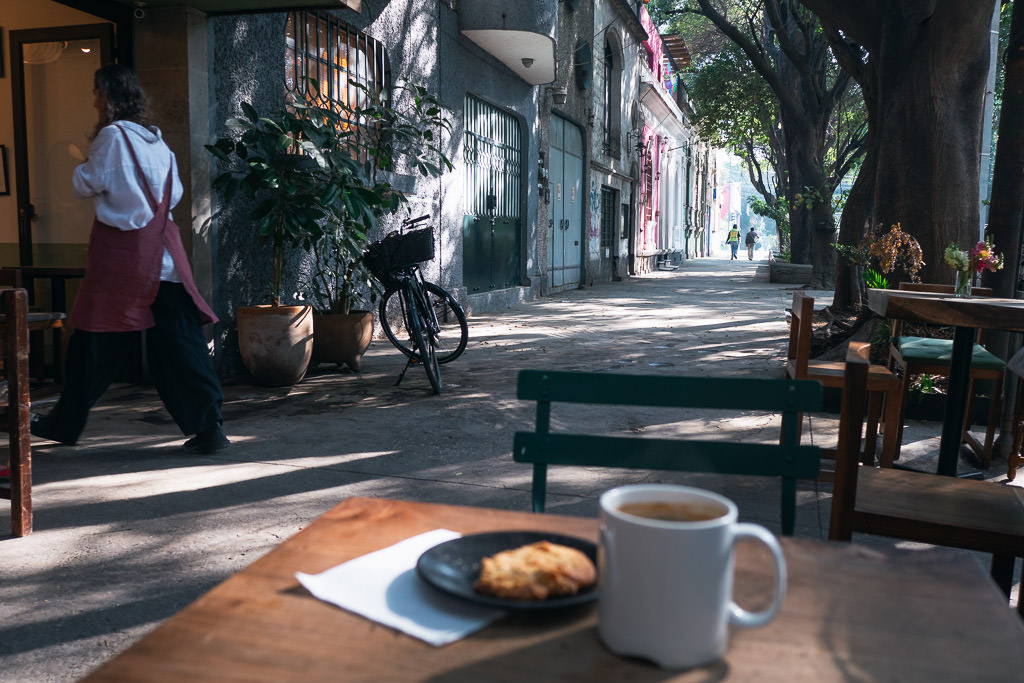 Coffee and a cookie with a view
Coffee and a cookie with a view  Finding a slice of green in the heart of Roma
Finding a slice of green in the heart of Roma 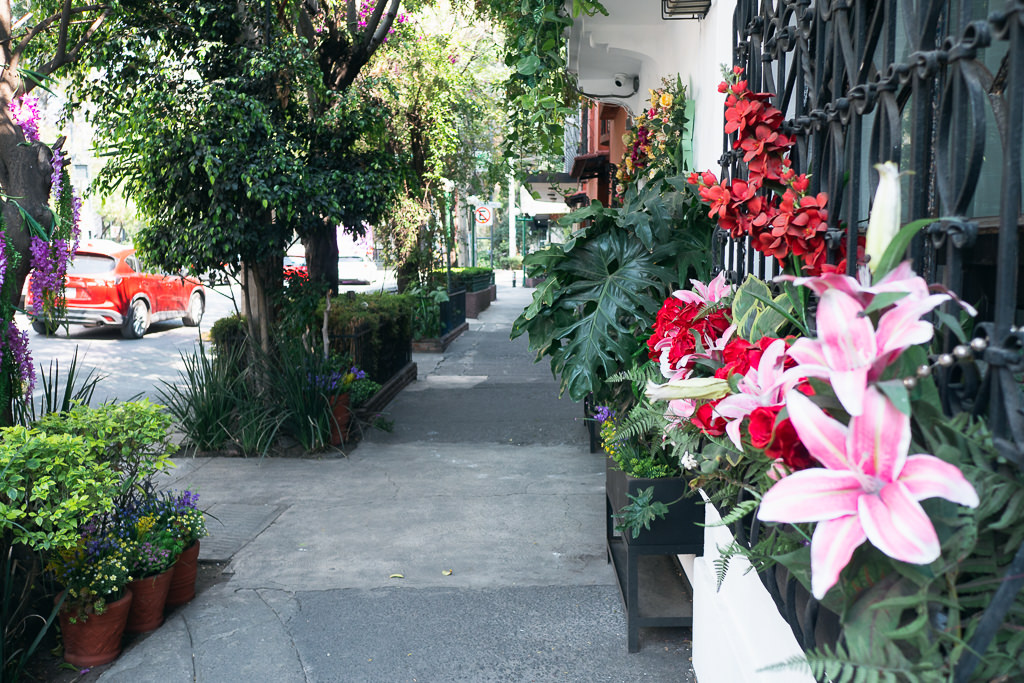 A burst of blooms on a Roma Norte stroll
A burst of blooms on a Roma Norte stroll 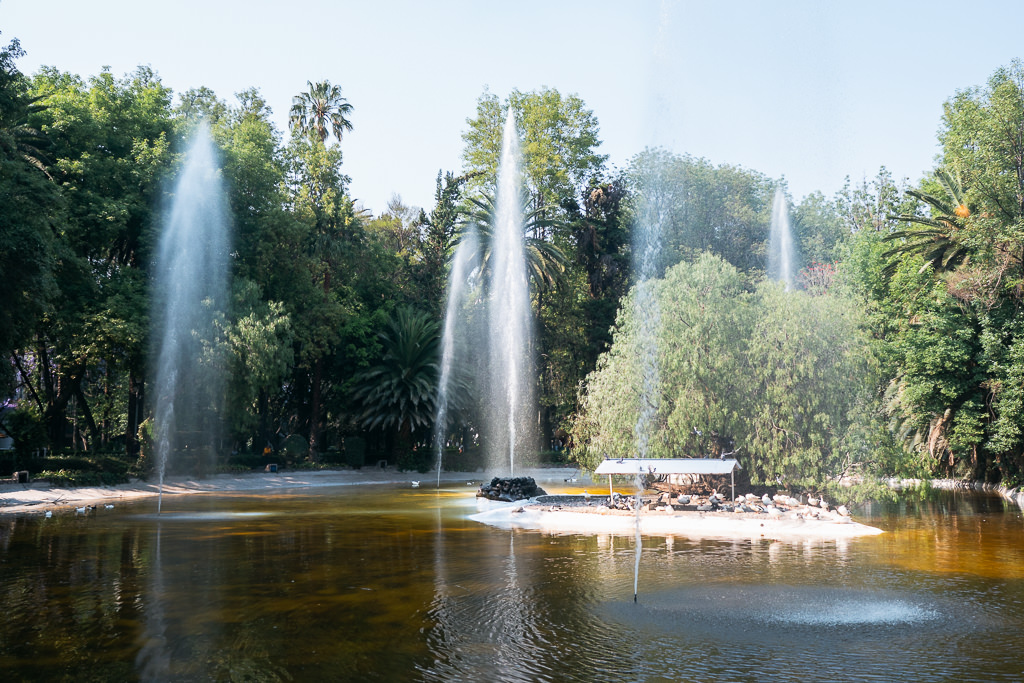 The Lago del Parque México with its prominent water displays
The Lago del Parque México with its prominent water displays
Roma Norte brings a certain hipster vibe to this metropolitan city. You’ll find a lot of unique shops, trendy restaurants, and cafes. It’s definitely where all the cool kids hang out. Prices in restaurants are often closer here to US prices, and you may hear more English than in other areas of CDMX, but this also makes it especially tourist-friendly and a perfect introduction to your Mexico itinerary.
Avenida Alvaro Obregon is the main street that runs through Roma. Plenty of people will be out for a morning stroll, walking their dog, or grabbing coffee.
Adjacent to Roma Norte is Condesa, which is one of my favorite boroughs in Mexico City. It’s a bit more trendy and attracts a younger crowd, so it’s definitely a fun place to spend the evenings. You can explore green parks, small shops, and cafes, and it’s full of active people jogging or riding bikes.
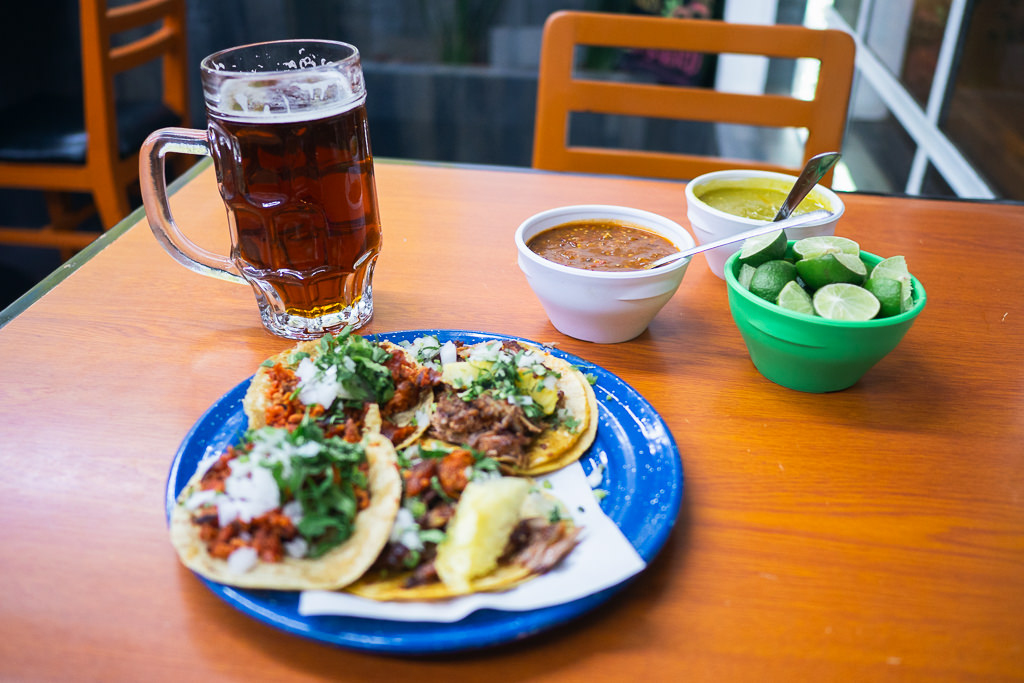 The classic Tacos al Pastor… simple, authentic, reliably delicious
The classic Tacos al Pastor… simple, authentic, reliably delicious
While you’ll find a variety of international dining options, it’s also a great area to explore authentic Mexican cuisine. If you’re ready to dive right into the local life, go for it!
If you want something more traditional and low-key for your meals, there are heaps of street taco stands throughout the city, and they are seriously out of this world. Whenever I’m in Mexico, I’ll dig into a plate of tacos al pastor pretty much every single day. I mean, about 16 pesos for a taco, you can’t beat that.
An excellent way to get introduced to the cuisine is to take a foodie tour of the local markets. I find that doing a food tour is the perfect activity for your first day, as knowing how to order some new dishes and treats will pay dividends throughout the rest of your trip!
If you plan to explore Downtown Mexico City, don’t miss this food-tasting tour to try the best traditional food the city has to offer.
Easily follow my itinerary with this custom Google Map
Each day is a different color – top left icon reveals waypoints
Day 2: Dive into the historic center (El Centro)
El Centro is where you’ll find all of Mexico City’s famous landmarks, such as theMetropolitan Cathedral and Templo Mayor.
Start your morning off with a stroll through Alameda Central Park and a visit to Torre Latinoamerica. You’ll get some amazing views of the city from the top of this office tower, which is why it’s definitely something worth doing first! See exactly where you’ll be walking and what the layout of the city looks like. I love to get a bird’s eye view of the city before I dive into exploring it.
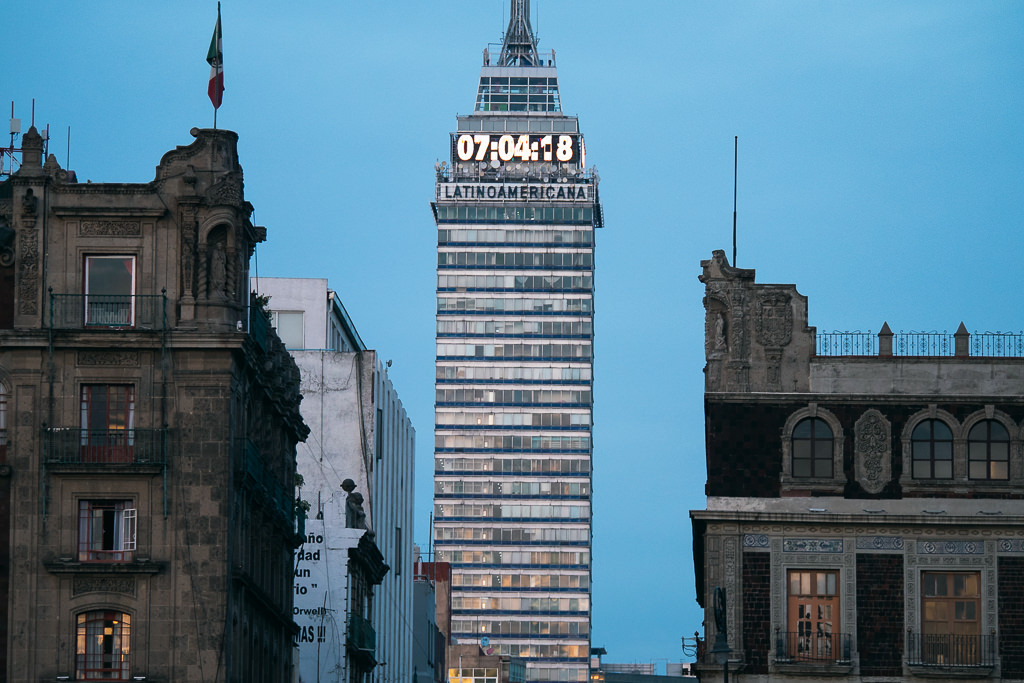
From here, it’s worth paying a visit to the beautiful Palacio de Bellas Artes. The magnificent Art Deco building features an opera house, a theatre, and art from around the world. Also, the museum features a captivating mural by Diego Rivera that portrays Mexico’s history, starting from the Aztec civilization and continuing through the 20th century.
When you’re done, go across the street and into the Sears department store. Head to the 7th floor where you’ll find a Finca Don Porfirio, which has a balcony offering a perfect viewing angle onto the beautiful domed building.
 Palace of Fine Arts
Palace of Fine Arts
Next, don’t miss the Museo Nacional de Arte Popular, which houses some fantastic traditional Mexican art. If you have colorful visions of Mexico akin to films like Pixar’s Coco, then you’ll love the Mexican visual culture that’s explored in this terrific medium-sized museum.
The museum displays folk art from various regions of Mexico, portraying the country’s history and diverse cultures. Among the exhibits are Tecali’s glass art, pottery from Michoacán, Chiapas’ masks, and Oaxaca’s alebrijes, which are painted animal figures. It’s colorful, it’s vibrant, and it really captures the essence of Mexican culture.
Tip: Most museums are closed on Mondays, including the Popular Art Museum and Templo Mayor. Be sure to shift your itinerary around if necessary. Teotihuacán (see next section) is open on Mondays, so you can slot this in instead.
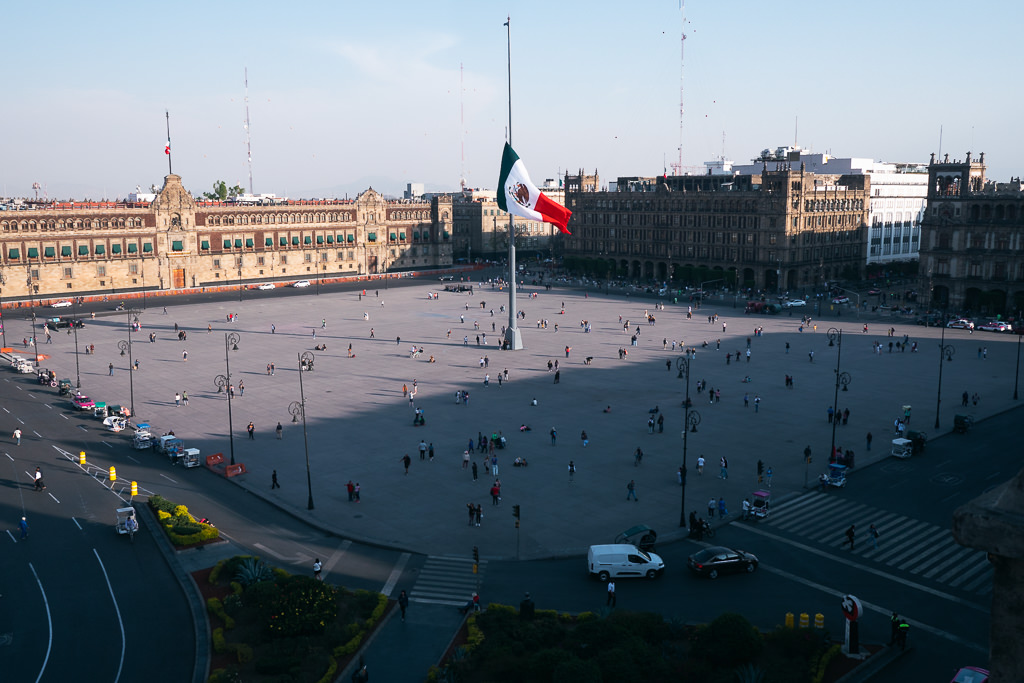 The historic Zócalo, or the Central Plaza
The historic Zócalo, or the Central Plaza  Museum of Popular Arts
Museum of Popular Arts 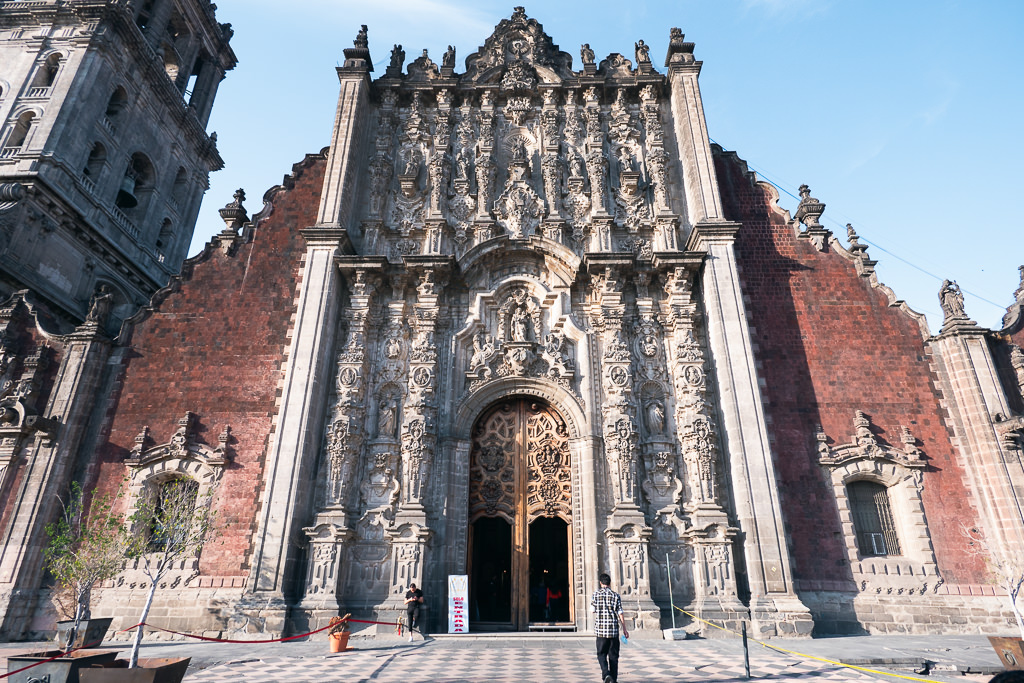 Metropolitan Cathedral in Mexico City
Metropolitan Cathedral in Mexico City 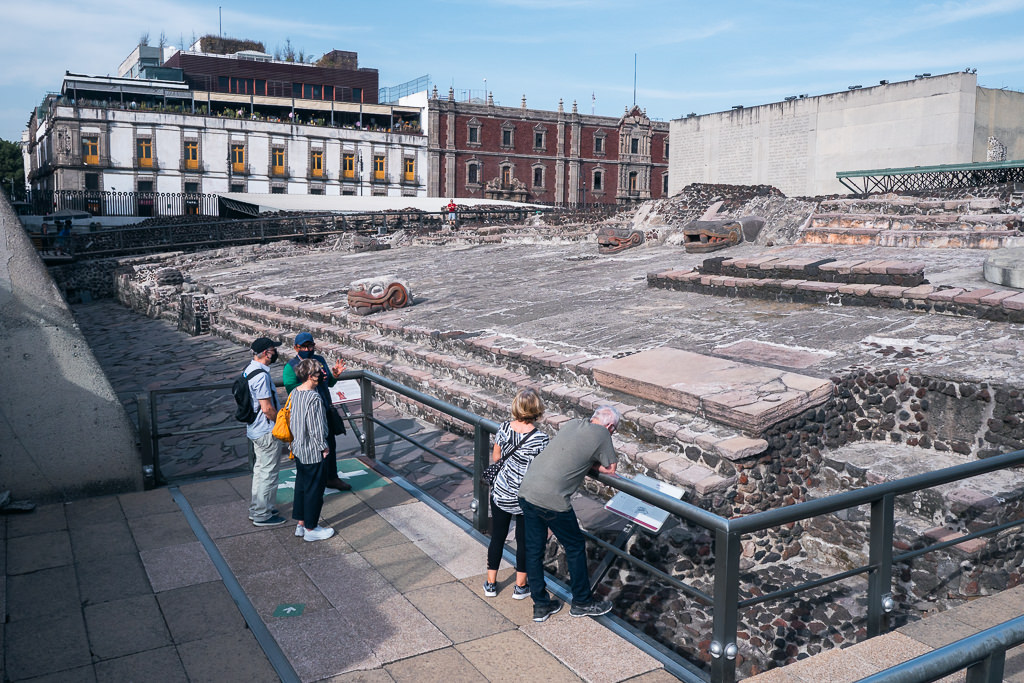 Templo Mayor
Templo Mayor
Finally, let’s head to Zocalo (main square). It’s one of Mexico City’s most iconic spots and is one of the largest public squares in the world.
From here, you can wander around and explore more of the historic center. Be sure to stop by the Templo Mayor, the remains of the Aztec Pyramid that once stood at the center of the city, and which was excavated beginning in 1978.
Not much remains of the original structure, so it requires a bit more imagination to appreciate than more intact sites like Teotihuacán, but the ruins and adjacent museum are still a fantastic primer on the ancient culture that was once at the heart of what is today Mexico City.
As the day winds down, grab dinner at one of the many restaurants in El Centro. A nice choice is Balcon del Zocalo, which will give you great views of the Zocalo and is a great spot to end your day.
Day 3: Day trip to Teotihuacán
You can’t go to Mexico City and not visit the ancient ruins of Teotihuacán. However, my one tip is to start your day early because it’s located a little far from Mexico City.
From the northern bus terminal, it takes about an hour to get to Teotihuacán, but the total travel time can take twice that if you’re including potential traffic delays and getting to the bus terminal. An early start will ensure you’ll still have plenty of time to explore the pyramids.
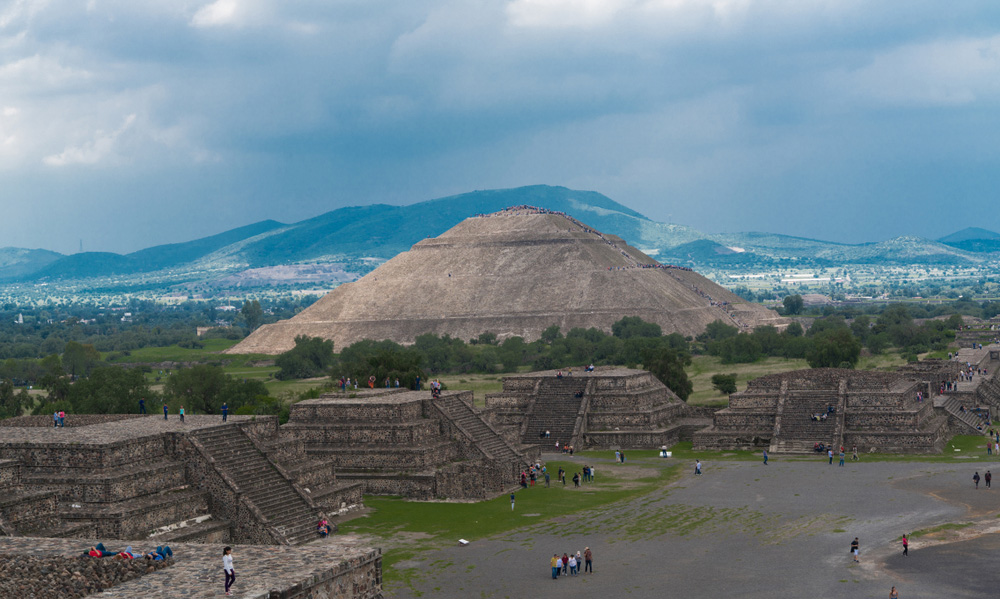 The ancient magnificence of Teotihuacan
The ancient magnificence of Teotihuacan
The two main structures, the Pyramid of the Sun and the Pyramid of the Moon, are certainly awe-inspiring, but keep in mind that you can no longer climb all the way to the top of these structures. You can either admire them from the ground level, or you need to get up in the air to really see them in their full glory (more on this below).
After you’ve explored the ruins, take some time to wander around the little shops and cafés in the area.
While you can get to Teotihuacán by yourself, there are also plenty of tours that will take you to Teotihuacán directly from your hotel in Mexico City. They also have the benefit of an expert guide who can give you a real feel for the history of the place.
I found that without a guide, Teotihuacán takes at most an hour or so to see, and while the architecture is obviously epic, you’ll miss some of the context and stories that make it come to life.
Another way to experience the pyramids is by taking a hot air balloon ride over the pyramids. This doesn’t come cheap (balloon rides never do!), but watching the sunrise reveal the mountains and the temples is an unforgettable experience for sure.
What to expect: You’ll catch the sunrise lighting up the pyramids and mountains in a warm, golden glow — it’s the kind of bucket-list adventure you’ll remember for a lifetime.
BOOK THIS Hot Air Balloon TOUR
Day 4: Chapultepec Forest and around
Day 4 is all about exploring Chapultepec Forest, the largest urban park in Mexico City. It is also, in effect, a museum quarter, being home to several of the best museums.
Starting from the east entrance near the Chapultepec metro station, you can walk around and explore all of the different areas. Stroll toward the Chapultepec Castle, which is perched atop the hill and offers stunning views of the city.
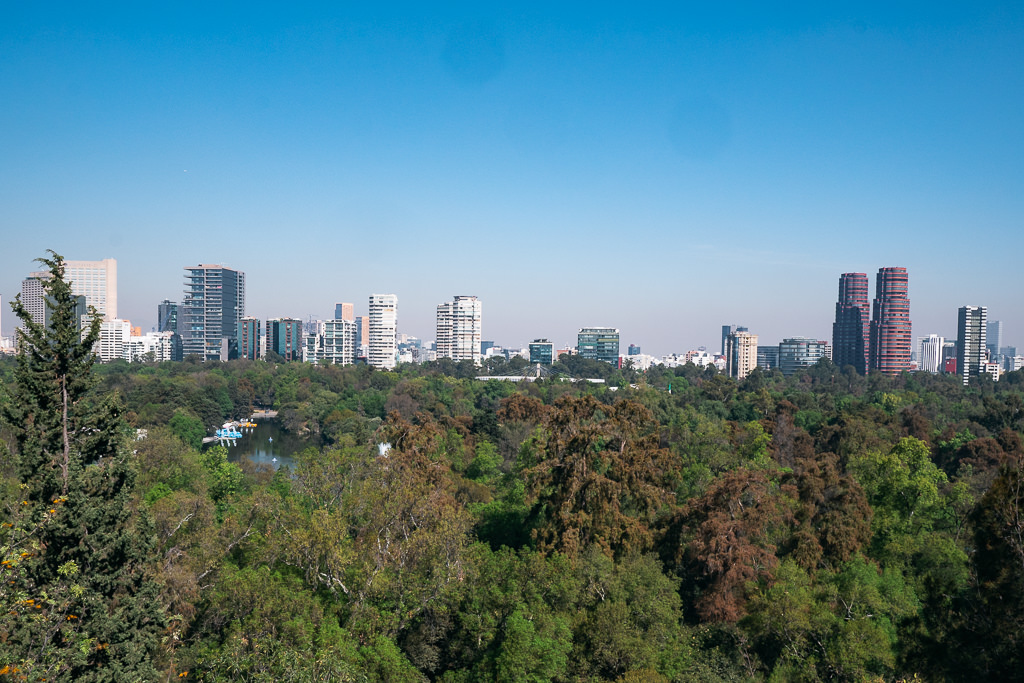 A view of Chapultepec Forest
A view of Chapultepec Forest  Chapultepec Castle
Chapultepec Castle
Several famous museums in the area should definitely be included in your 1 week Mexico City itinerary. The Museum of Anthropology is the most incredible museum in the city, and honestly, maybe the whole country.
It’s highly acclaimed due to its massive size and impressive collection of ancient Mexican artifacts. The Aztec Temple ruins located in the center of the museum are the highlight, along with the renowned “Sun Stone” on display, one of the world’s most famous Aztec artifacts.
For lunch, you can simply stay in the park, where numerous small eateries with outside seating can be found near the lake. (Look for the Zona de Comida on Google Maps.) The stalls here will let you try a huge variety of Mexican dishes, ranging from the famous pozole stew to a delicious mole negro (black sauce) from the Oaxaca region.
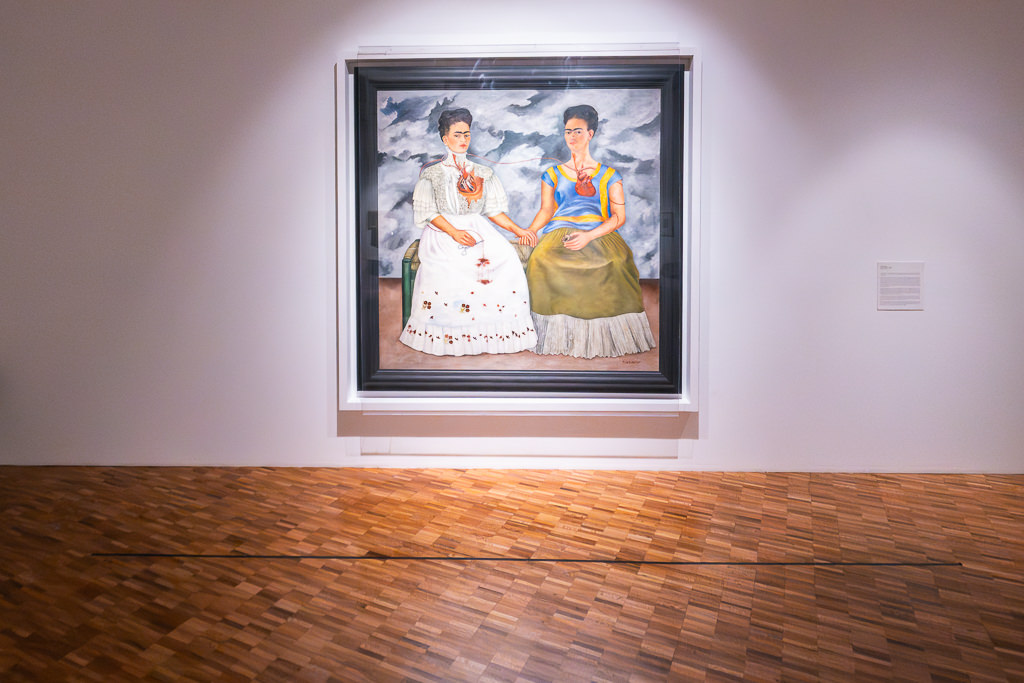 Frida Kahlo’s iconic works at Museo de Arte Moderno
Frida Kahlo’s iconic works at Museo de Arte Moderno  A sneak peek into exhibits showcasing Mexico’s greatest ancient civilizations in the Museum of Anthropology
A sneak peek into exhibits showcasing Mexico’s greatest ancient civilizations in the Museum of Anthropology 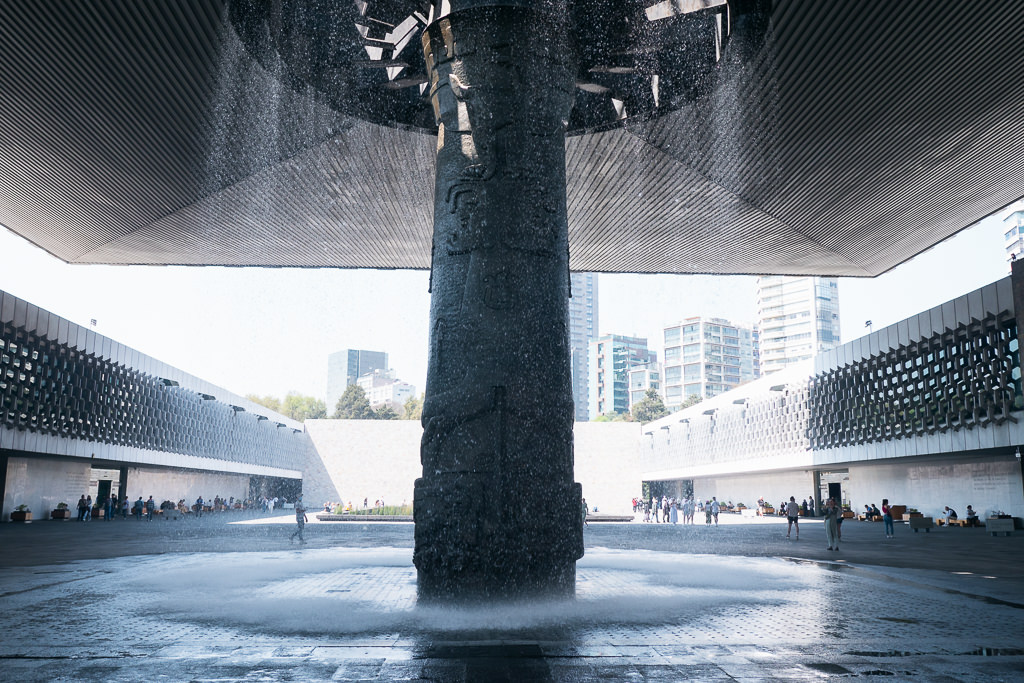 Standing tall in the Museum of Anthropology’s central courtyard, “El Paraguas” (The Umbrella) – a stunning blend of art and architecture
Standing tall in the Museum of Anthropology’s central courtyard, “El Paraguas” (The Umbrella) – a stunning blend of art and architecture
In the afternoon, you can visit the Museo de Arte Moderno, one of the best modern art museums in Mexico. If you love contemporary works of art, this is a must-see. It houses art from Frida Kahlo, Diego Rivera, and many other Mexican artists.
Day 5: Day trip to Coyoacán and Xochimilco
Today, you are going to do one of my favorite things in Mexico City—visit Frida Kahlo’s museum! Frida Kahlo is a legendary Mexican artist, and her legacy is widely recognized worldwide. Her unique self-portraits offer insight into her life and the challenges she experienced.
The Frida Kahlo Museum, also known as La Casa Azul, is located in the Coyoacán neighborhood. The museum is situated inside Kahlo’s former home and showcases her life and work through a collection of her famous paintings and personal belongings.
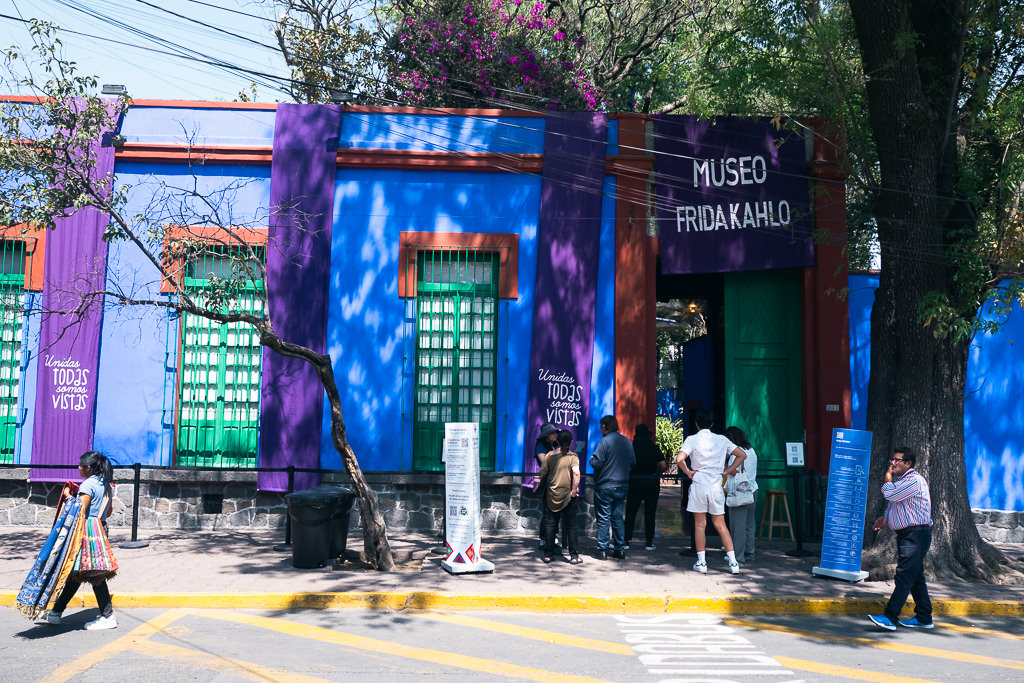 Frida Kahlo’s colorful former home, turned museum, in the heart of Mexico City
Frida Kahlo’s colorful former home, turned museum, in the heart of Mexico City
If you’re not very familiar with her, be sure to watch the excellent 2002 film Frida before you go, as it will definitely bring you up to speed.
Don’t leave booking your tickets too late! This is the no. 1 most visited museum in Mexico City, and it’s not uncommon for it to be booked out several days in advance. To avoid missing out, I recommend pre-booking your entry tickets.
If you book via GetYourGuide, you also get the option for early access, which is worth considering as this museum gets quite crowded. If you don’t go for early access, consider booking the first normal timeslot of the day (10 am).
After visiting the museum, take a walk through the Coyoacán neighborhood, which is one of the oldest in Mexico City. Coyoacán was actually its own city for a long time, serving as the capital of New Spain in the colonial era, but it slowly became enveloped by Mexico City as it grew. It still very much feels like a town inside the city with its own identity.
With colonial-style architecture and leafy squares, it has a wonderfully inviting atmosphere. There are many shops, cafes, and restaurants to check out here.
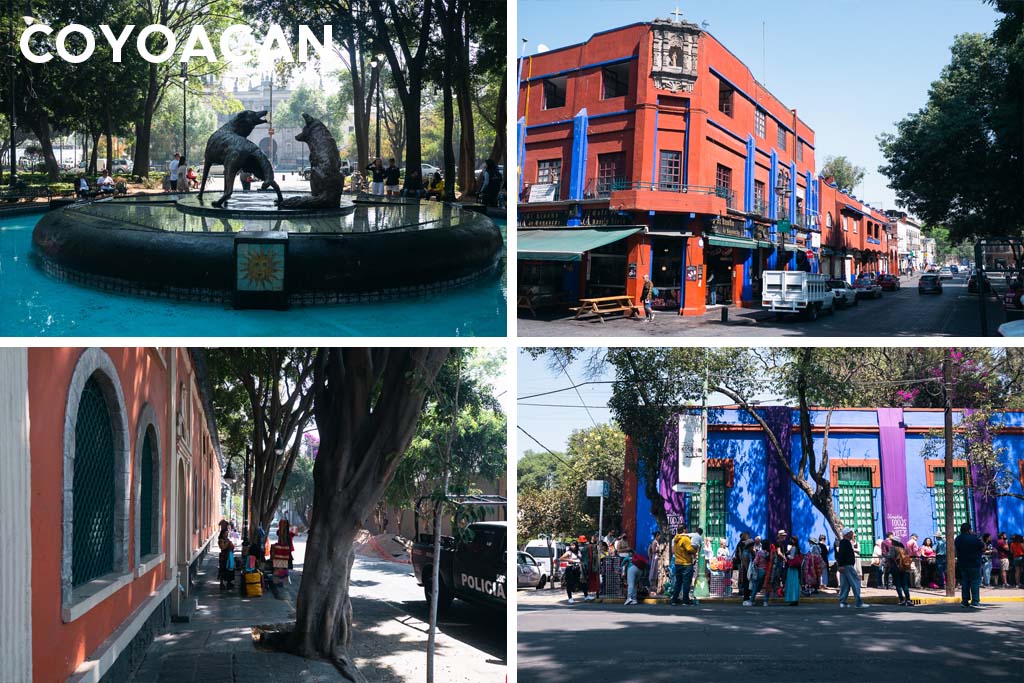 Coyoacán in a glimpse
Coyoacán in a glimpse
In the afternoon, head to Xochimilco, which is part of the old Aztec canal system, and you can explore it by taking a ride in a traditional “trajinera” boat. The boats are brightly colored and filled with mariachi bands.
Although it may seem a bit tacky, it’s one of those experiences that make Mexico City so worth visiting — and it’s actually something that city residents love to do, especially on the weekends.
By the way, the waters of Xochimilco are the home territory of the axolotl, a unique and rare salamander that has captured the popular imagination in recent years, even becoming somewhat of an internet meme. These cute creatures are critically endangered, so you’re unlikely to spot one in the wild, but you may notice axolotl iconography, murals, or street art in CDMX.
There is also a small animal sanctuary in Xochimilco where you can see captive axolotls (they’re bred to be released) and learn all about them. It’s on an island that’s hard to reach without a boat, but a stop here is included in some tours, including this one.
If you’re up for a fun, full-day experience in Mexico City, this tour is one of the coolest out there.
It takes you through the colorful canals of Xochimilco, the charming streets of Coyoacán, and the iconic Frida Kahlo Museum—plus a stop at the stunning UNAM Central Library.
The cool thing is that everyone on the tour brings their own drinks for the boat ride, which quickly turns into a full-blown floating party. Between the mariachi bands, the shared snacks, and the festive vibes, it’s a guaranteed good time.
Days 6 & 7: Day trips outside Mexico City
CDMX is very centrally located in Mexico, so it’s the perfect home base to explore a few different places nearby. For your last two days, you can fill them up however you like. These are just some ideas depending on how you’re feeling after your jam-packed week in Mexico City.
Consider one or two of the following:
 Start in Mexico City, but don’t stop there — the rest of the country is a breathtaking patchwork of stories, flavors, and surprises
Start in Mexico City, but don’t stop there — the rest of the country is a breathtaking patchwork of stories, flavors, and surprises
1. Puebla
If Mexico City can sometimes seem a bit much, consider a day trip to the more laid-back and less traffic-filled Puebla.
The city was founded in 1531 and was declared a World Heritage Site by UNESCO in 1987. Here, you’ll find some lovely colonial churches, museums and art galleries, colorful markets, and plenty of delicious Mexican food. It has a colorful old center with a relaxed atmosphere. The nearby town of Cholula, famed for its Great Pyramid, combines well with a trip to Puebla.
It’s about 2 hours by bus from Mexico City to Puebla; you can check transport connections here.
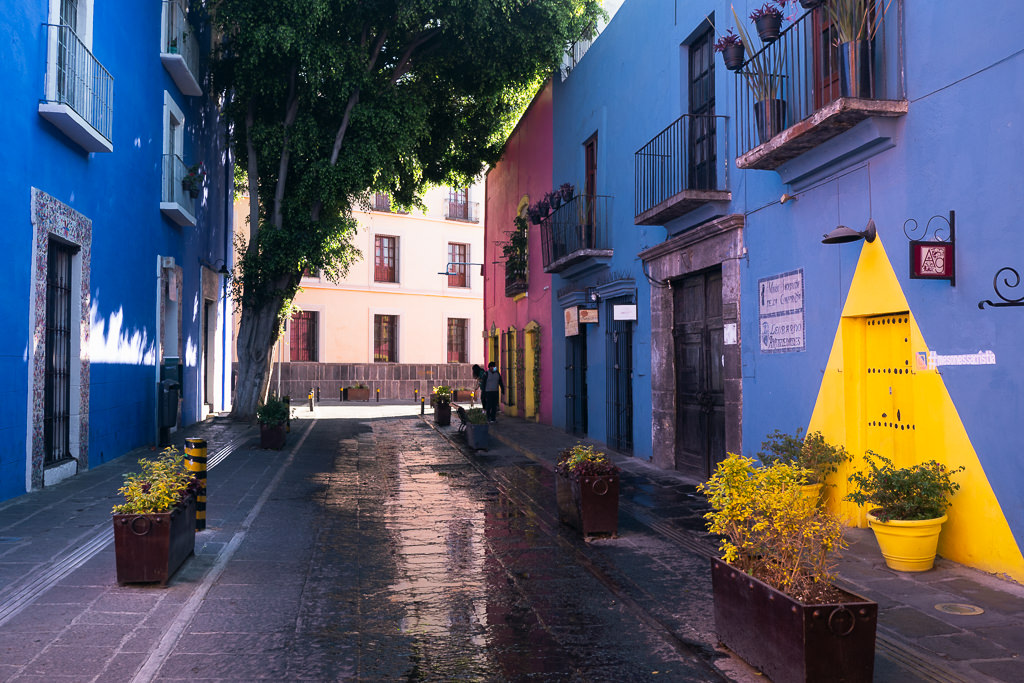 Streets in Puebla are a color explosion
Streets in Puebla are a color explosion
Puebla is a useful launching point for visiting the Tehuacán Biosphere Reserve—a UNESCO World Heritage Site famed for its towering cacti, ancient agave plants, and dramatic desert landscapes. It was actually added to the UNESCO list in 2018, but it’s still very much a hidden gem as it hasn’t made it onto the typical itineraries yet.
The reserve feels like a different world entirely, with landscapes that shift from dry valleys to rugged mountains, and an unexpectedly rich biodiversity. You can go hiking, learn about traditional uses of agave, or just soak in the silence of the desert; this place is sure to leave a lasting impression.
If you want to visit Puebla as a daytrip without worrying about public transportation, you can easily book a small group tour with pickup from your hotel in Mexico City.
visit Puebla & Cholula Pyramid
2. Taxco
Another great stop is Taxco, a colonial town built on several hills with many narrow cobbled streets. It’s known as the Silver Capital of Mexico—and if you’re looking to buy some silver jewelry, this is definitely the place! Take a walk around town and explore its beautiful architecture, visit one of the many silver shops, and sample some local cuisine — such as the unique dish of pozole, which originates here.
It’s about a 2.5-hour bus ride from the southern bus terminal in Mexico City. If traveling independently, consider making it a 2-day trip with an overnight stay in Taxco. You can also book an organized Taxco day trip from Mexico City that will let you easily see all the highlights, plus make a stop in the beautiful city of Cuernavaca.
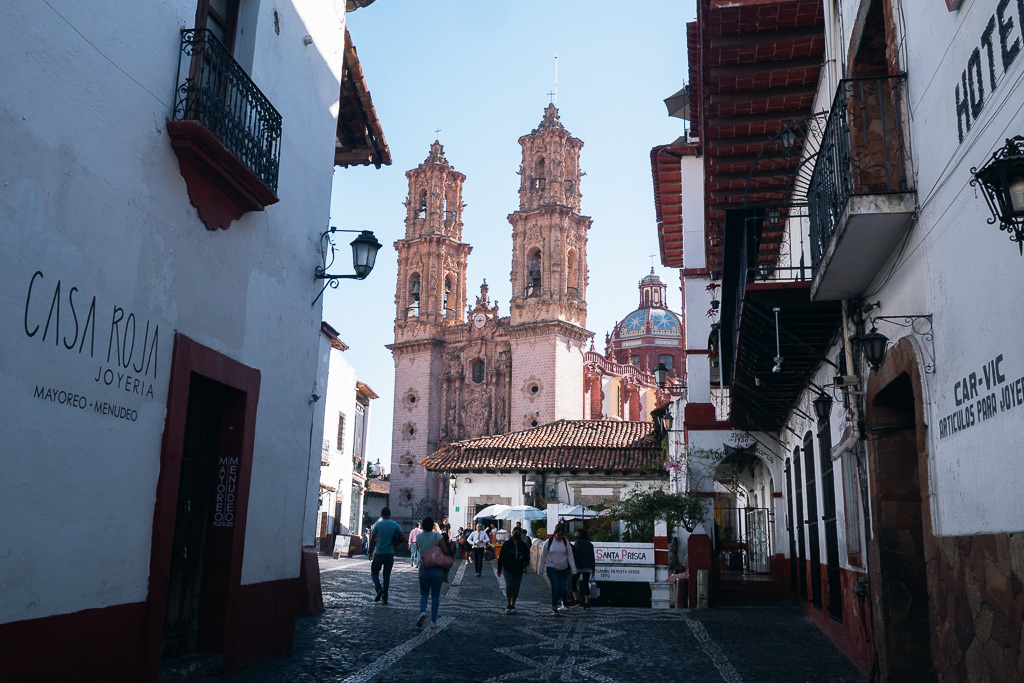 Sunny streets and a view of Santa Prisca Chruch
Sunny streets and a view of Santa Prisca Chruch 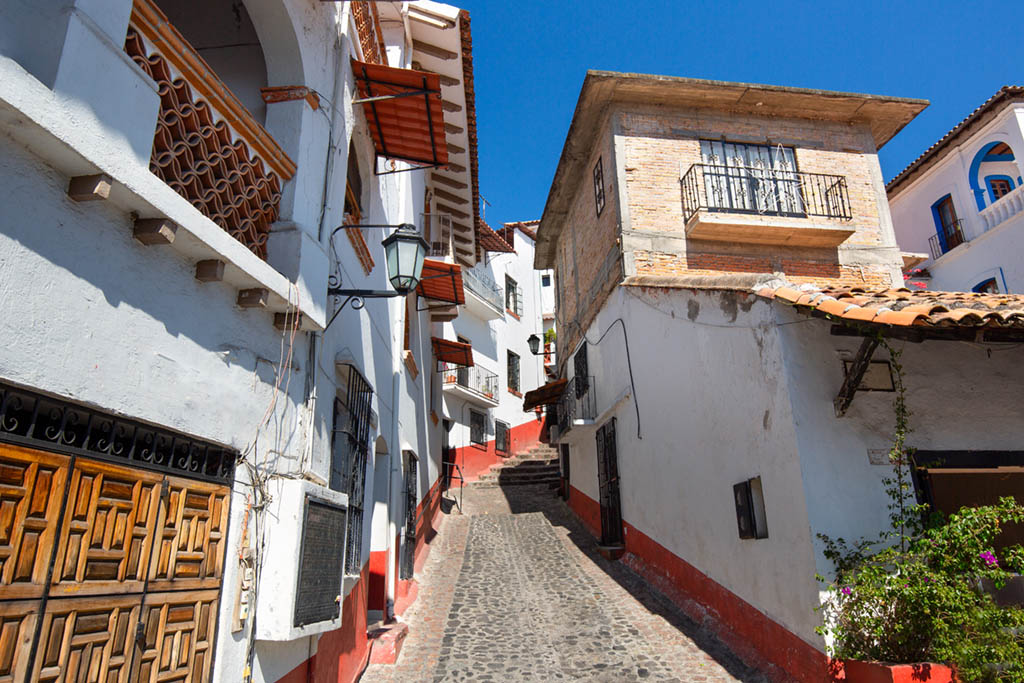 Winding streets and white façades create the feeling of a Tuscan village… except in Mexico
Winding streets and white façades create the feeling of a Tuscan village… except in Mexico
Despite being such a lovely town, Taxco flies hugely under the radar. It’s probably because other regions further south in Guerrero State have suffered from many safety issues, so Taxco often gets lumped in with them.
As of 2025, the town is essentially on the border of the areas typically labeled “safe for tourists”, so you may still wish to consult safety advisories before you go (and avoid travelling further south).
That said, I love Taxco and consider it a hidden gem. Since it’s a bit further out of the way from Mexico City, consider making it a 2-day stay. Note that it’s a popular weekend trip for many locals, so it will be noticeably busier then.
Explore Taxco & a Pre-Hispanic Mine
3. Volcano hikes
 Popocatépetl volcano – its snowy cone seen from Puebla
Popocatépetl volcano – its snowy cone seen from Puebla
CDMX is surrounded by several mighty volcanoes. Due to their steep inclination, they make for stiff hikes, but this makes them all the more rewarding, too.
Popocatépetl and Iztaccihuatl are two of the most popular volcanoes to hike, and both of them offer stunning views. If you want to experience a day of hiking the surrounding volcanoes, consider this guided hike with an alpinist for a safe and memorable experience.
Hike the majestic Iztaccihuatl Volcano
4. Queretaro and Peña de Bernal
Queretaro is an attractive yet less-visited gem in Mexico, about 3 hours from the capital (check for bus services to Queretaro). The city dates back to 1531 and has some of the best-preserved colonial architecture in Latin America—it’s even been recognized as a UNESCO World Heritage Site.
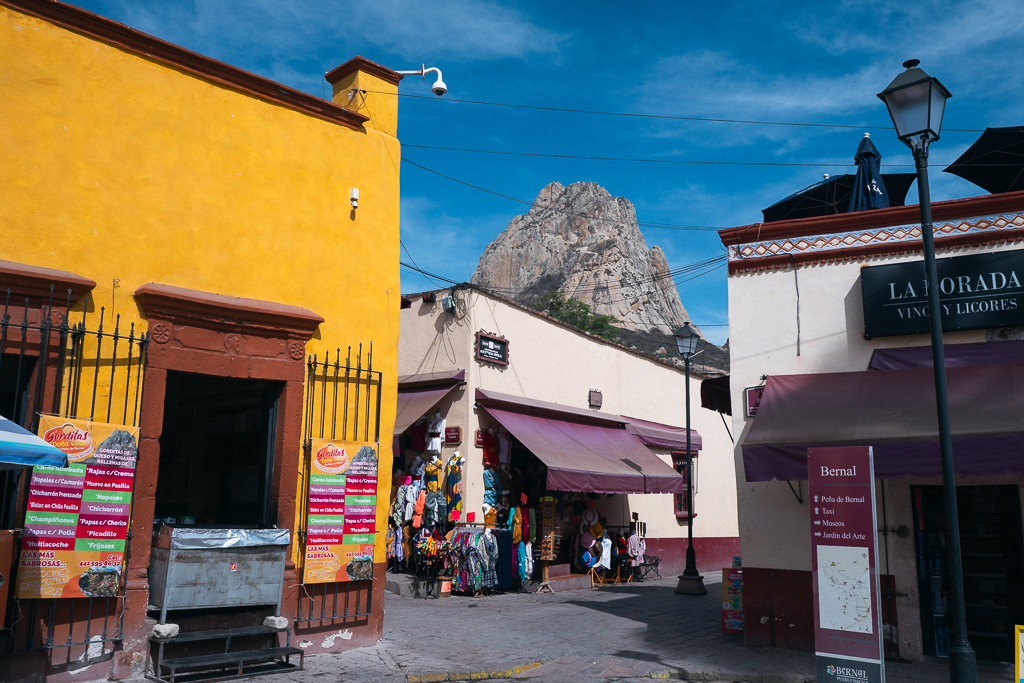
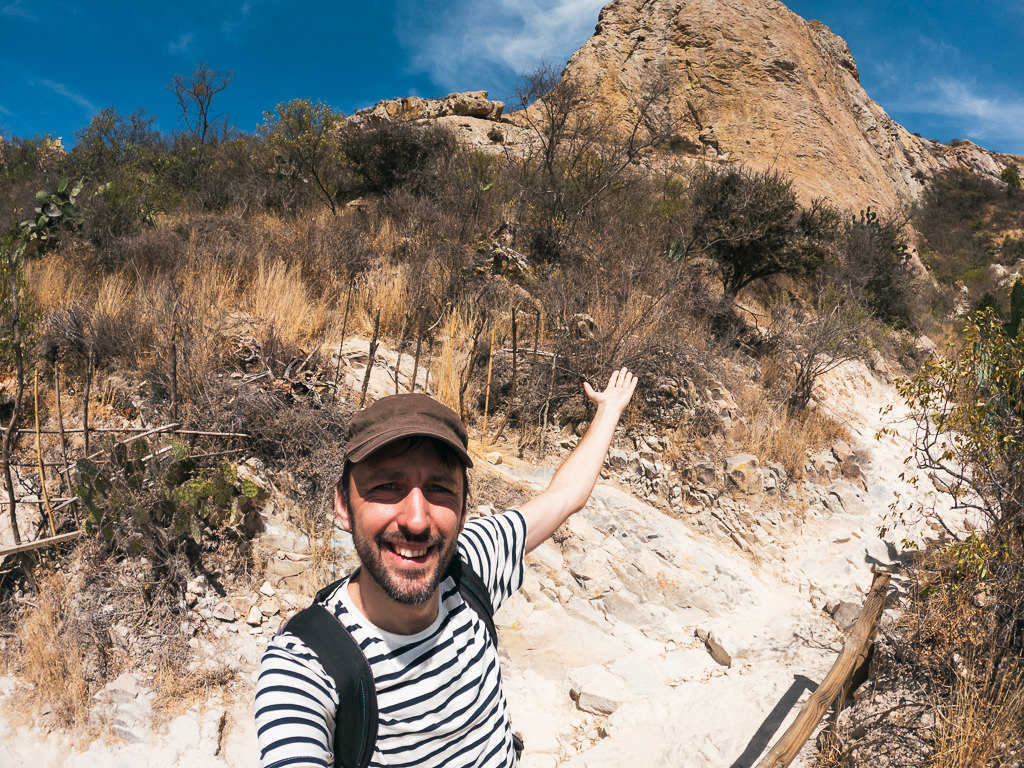
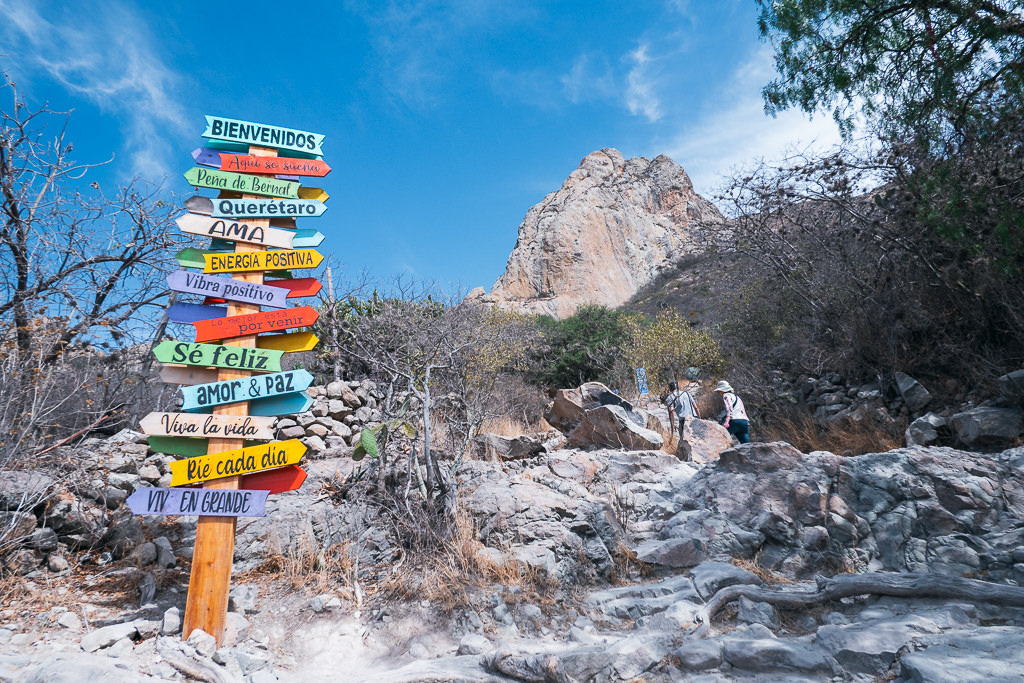
From Queretaro, you may want to head to Peña de Bernal, a town that’s home to the world’s third-tallest monolith. A monolith is a mountain that stands on its own in the landscape; other examples include Sugarloaf in Rio de Janeiro or the Rock of Gibraltar. You can hike up to about halfway up for some very rewarding views (getting to the top is for mountaineers only). The experience is best on weekdays when there are much fewer people.
Back in town, be sure to try the gorditas, a type of thicker taco that many of the restaurants here specialize in.
How to see the ‘real’ Mexico City
In this guide my goal has been to cover some of the classic highlights and must-see sights in Mexico City. But beyond the big museums and busy plazas, Mexico City hides a quieter magic—hidden gems and neighborhoods where the city’s true character comes through.
Intrigued? The best way to find these spots is by grabbing a map, staying curious, and having the courage to just wander. That sense of curiosity might lead you to Mercado Jamaica, one of the city’s most vibrant and colorful flower markets. Or you might stumble into Santa María la Ribera, one of Mexico City’s oldest neighborhoods. You never really know what you’ll find—but that’s the fun of it.
Our contributor, Dustin, spent a year exploring CDMX and shares this wonderful guide to its hidden neighborhoods, in which he explains his method for finding non-touristy areas of interest guided by the Mexico City metro grid. Check it out for some tips on more lowkey and close-to-the-ground exploration of this magnificent metropolis, if that’s your style.
I hope this guide to a week-long stay in Mexico City has helped you get an idea of what you can do and experience while in this fantastic city!
You should have plenty to keep yourself busy for the week. From exploring ancient ruins to sampling some delicious Mexican cuisine, you’re gonna fall in love with this city for sure.
